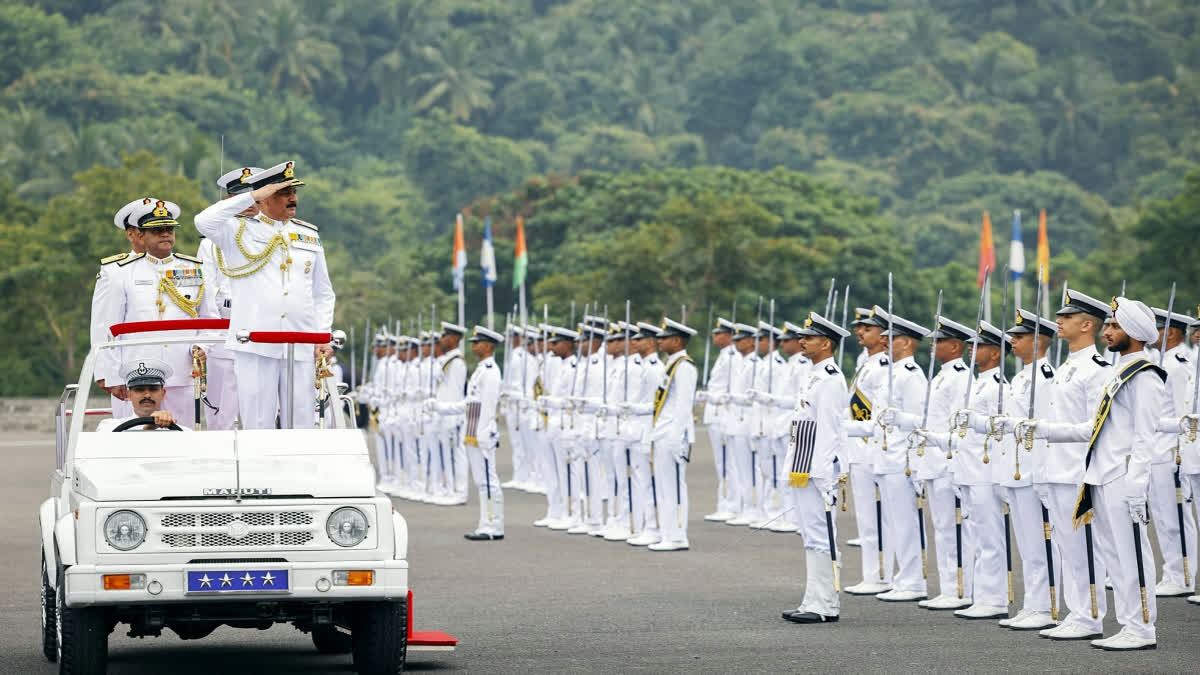Hyderabad: Indian Navy Day, observed every year on December 4th, pays tribute to the accomplishments of the Indian Navy and marks the success of Operation Trident in the 1971 Indo-Pak War.
This day honours Navy members who gave their lives for the country. Functioning as a three-dimensional power, the Indian Navy protects our interests on, above, and beneath the ocean surface, with an emphasis on the Indian Ocean Region. Every year, festivities feature different activities and distinct themes.
The Indian Navy plays a crucial role in safeguarding India's maritime borders along the coast. India boasts a coastline stretching approximately 7500 kilometers and an Exclusive Economic Zone (EEZ) exceeding 2 million square kilometers. The Indian navy safeguards the Bay of Bengal in northeastern India and the Arabian Sea in southern India. India possesses a robust navy consisting of approximately 150 vessels, 17 destroyers, and numerous courageous soldiers.
History Behind The Day:
Indian Navy Day is celebrated on December 4th to honour the bravery, skill, and commitment of the Indian Navy in protecting the country's sea borders. It remembers the success of Operation Trident during the 1971 Indo-Pak War, when the Navy smartly attacked Pakistan's Naval Headquarters in Karachi. This operation, led by Commodore Kasargod Pattanashetti Gopal Rao, used missile boats like INS Veer, INS Nipat, and INS Nirghat to sink three Pakistani ships, including PNS Khaibar, causing major damage.
Navy Day Theme 2024:
The theme for Indian Navy Day 2024 is 'Strength and Capability through Innovation and Indigenization'. This theme highlights the Navy's aim to be self-reliant and improve technology, which helps make its operations stronger and keeps maritime security safe.
Role of Navy:
The full range of operations in which a nation's naval forces may be involved is vast, ranging from high intensity war fighting at one end to humanitarian assistance and disaster relief operations at the other. This broad continuum of operations can be broken down into distinct roles, each demanding a specific approach to the conduct of operations. The four main roles envisaged for the Indian Navy are:
The Military Role: The military function of the Navy is defined by the potential or actual use of force at and/or from the sea. This encompasses the use of maritime power in both offensive actions against enemy forces, territory, and trade, as well as defensive actions to safeguard one’s own forces, territory, and trade. The military function is executed by achieving particular military goals, missions, and tasks.
The Diplomatic Role: Naval diplomacy involves employing naval forces to further foreign policy goals aimed at creating 'bridges of friendship' and enhancing international collaboration, while also demonstrating capability and intent to dissuade possible adversaries.
Constabulary Role: Safeguarding and advancing India's maritime security is a key duty of the Indian Navy. This encompasses a policing component, particularly in regard to threats that entail the use of force on the water. The range of responsibilities that the Indian Navy must conduct in its constabulary role spans from Low Intensity Maritime Operations (LIMO) to ensuring order at sea. This also encompasses coastal security elements, as a component of India's comprehensive maritime security.
Benign Role: The ‘benign’ role is termed as such because violence is absent in its execution, and the possibility of using force is not a required condition for carrying out these activities. Instances of harmless tasks consist of humanitarian support, disaster response, Search and Rescue (SAR), explosive disposal, diving support, salvage efforts, hydrographic assessments, and so forth.
The Indian Navy’s New-Age Technological Breakthroughs:
The Indian Navy is all set to introduce its latest Indigenization roadmap, known as ‘Swavlamban 2.0,’ to showcase the development of advanced defense technologies.
In 2022, as part of the Azadi ka Amrit Mahotsav, the Indian Navy pledged to advance at least 75 technologies. This remarkable progress has primarily been achieved through initiatives such as SPRINT (Supporting Pole-Vaulting in R&D through Innovation for Defence Excellence), the Naval Innovation and Indigenisation Organisation (NIIO), and the Technology Development Acceleration Cell.



